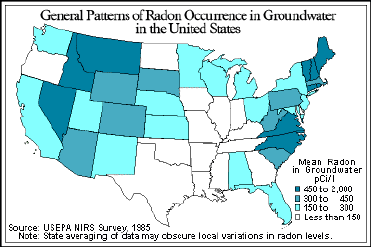Radon in Water
Radon gas can also enter homes through the water supply. Radon dissolves and builds up in water from underground sources, such as wells. The radon in your water can enter the air in your home when it is agitated or heated. This could happen during household activities such as showering, washing clothes, and cooking. Some radon stays in the water. Radon in the water you drink can contribute to a very small increase in your risk of stomach and other cancers. However, this risk is almost insignificant compared to your risk of lung cancer from radon in air.
For every 10,000 picocuries per liter (pCi/L) of radon in your water, it is estimated that 1 pCi/L is added to the air. If your water comes from a surface water source, like a lake, river, or reservoir, radon is not a concern as the radon is released into the air before it reaches your home.

For collection and analysis of radon in water, you should use the services of a qualified radon measurement professional and a lab approved by DPH to analyze radon in water (see below).
The Radon Program also maintains a list of nationally certified mitigation professionals who can reduce radon in water (see below).
Use the links below to find out more about radon in water:

